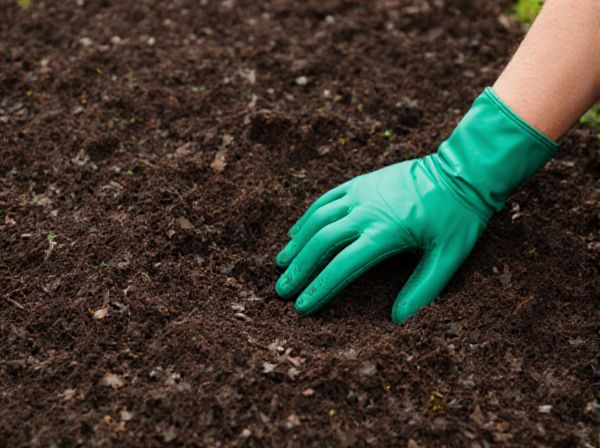
Rubber Mulch vs Wood Mulch Illustration
Rubber mulch offers longer durability and better drainage compared to wood mulch, making it ideal for playgrounds and gardens prone to moisture. Wood mulch, made from organic materials, enriches soil nutrients as it decomposes and provides a natural aesthetic. Choosing between the two depends on priorities such as environmental impact, maintenance, and soil health benefits.
Table of Comparison
| Feature | Rubber Mulch | Wood Mulch |
|---|---|---|
| Material Source | Recycled rubber tires | Natural wood chips and bark |
| Durability | Lasts up to 10 years, highly resistant to weather | Decomposes in 1-3 years, needs regular replacement |
| Cost | Higher upfront cost | Lower cost, widely available |
| Environmental Impact | Recycles waste tires, but non-biodegradable | Biodegradable, supports soil health |
| Drainage & Aeration | Good drainage, does not retain moisture | Enhances soil moisture retention and aeration |
| Color Options | Available in various colors, long-lasting fade resistance | Natural colors, fades over time |
| Pest Resistance | Repels insects, no fungal growth | May attract insects and fungi |
| Safety | Non-toxic, but can heat up in sunlight | Safe and natural, cooler surface |
Introduction to Rubber Mulch vs Wood Mulch
Rubber mulch, made from recycled tires, offers long-lasting durability and excellent drainage compared to wood mulch, which decomposes over time and enriches soil nutrients. Wood mulch, derived from natural tree bark or wood chips, provides a more organic aesthetic and helps maintain soil moisture but requires frequent replenishing. Both mulches serve as effective ground covers, but rubber mulch excels in low-maintenance landscaping due to its resistance to decomposition and insect damage.
Material Composition and Sources
Rubber mulch is primarily made from recycled tire rubber, offering durability and resistance to decomposition, while wood mulch consists of shredded bark, wood chips, or sawdust derived from trees like cedar, pine, or hardwood. Rubber mulch provides long-lasting cushioning ideal for playgrounds, whereas wood mulch originates from natural forestry byproducts, supporting soil health through gradual decomposition. The choice between rubber and wood mulch depends on environmental impact considerations and specific landscaping needs.
Installation and Application Differences
Rubber mulch installs quickly as it does not decompose and requires no replacement, making it ideal for playgrounds and landscaping where low maintenance is a priority. Wood mulch demands periodic replenishment due to natural decomposition, enhancing soil fertility but necessitating more frequent application in gardens and flower beds. The heavier weight of rubber mulch reduces displacement by wind or rain, while wood mulch's lighter texture is easier to spread but may wash away more easily.
Longevity and Durability Comparison
Rubber mulch offers superior longevity compared to wood mulch, often lasting up to 10 years without significant degradation, while wood mulch typically decomposes within 1 to 3 years. The durability of rubber mulch resists weather damage, insect infestation, and molding, making it ideal for long-term landscaping projects. In contrast, wood mulch requires regular replacement and maintenance due to its susceptibility to rotting and nutrient leaching.
Weed and Pest Suppression Effectiveness
Rubber mulch offers superior weed suppression due to its dense composition that blocks sunlight effectively, preventing weed germination better than wood mulch. Wood mulch can decompose and create an environment attracting pests like termites and ants, whereas rubber mulch is resistant to decay, reducing pest habitat and infestation risks. Both mulches provide some pest deterrence by disrupting habitats, but rubber mulch maintains its integrity longer, enhancing long-term pest control.
Safety and Environmental Impact
Rubber mulch offers enhanced safety by providing superior shock absorption, reducing injury risks in playgrounds compared to wood mulch. Its durability prevents frequent replacement, while wood mulch decomposes naturally, enriching soil but posing fire hazards and potential mold growth. Wood mulch is biodegradable and supports ecosystem health, whereas rubber mulch can leach chemicals, raising environmental concerns despite its longevity.
Soil Health and Plant Growth Effects
Rubber mulch, composed of recycled tires, offers long-lasting durability and weed control but lacks organic matter that improves soil structure and nutrient content, potentially hindering plant growth. Wood mulch decomposes over time, enriching the soil with essential nutrients like nitrogen and promoting beneficial microbial activity, which enhances soil health and supports robust plant development. Choosing wood mulch optimizes soil fertility and water retention, fostering a healthier environment for plant roots compared to inert rubber mulch.
Cost Analysis and Maintenance Needs
Rubber mulch typically incurs a higher upfront cost compared to wood mulch but offers greater durability and lower replacement frequency, making it cost-effective over time. Wood mulch requires more frequent replenishment due to faster decomposition, increasing maintenance expenses annually. Maintenance needs for rubber mulch are minimal as it does not absorb water or attract pests, while wood mulch demands regular monitoring for decay and pest infestations.
Aesthetics and Landscape Design
Rubber mulch offers vibrant, long-lasting color options that resist fading, making it ideal for modern landscape designs seeking bold visual impact. Wood mulch provides a natural, organic appearance that integrates seamlessly into traditional gardens, enhancing soil moisture retention and decomposing into beneficial nutrients. Choosing between rubber and wood mulch depends on desired aesthetic appeal, with rubber mulch favored for durability and vivid hues, while wood mulch suits earthy, rustic landscapes.
Conclusion: Which Mulch Is Best for Your Garden?
Rubber mulch offers long-lasting durability, excellent weed control, and low maintenance, making it ideal for playgrounds and high-traffic garden areas. Wood mulch provides natural nutrients, improves soil quality, and supports beneficial microorganisms, enhancing plant health and growth in garden beds. Choosing between rubber and wood mulch depends on your garden's specific needs, prioritizing soil enrichment with wood mulch or longevity and pest resistance with rubber mulch.
Rubber Mulch vs Wood Mulch Infographic

 gardendif.com
gardendif.com